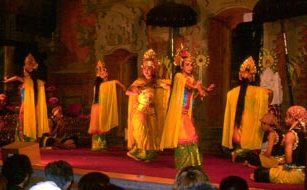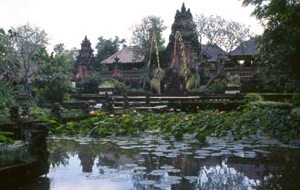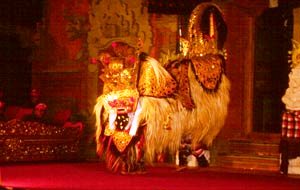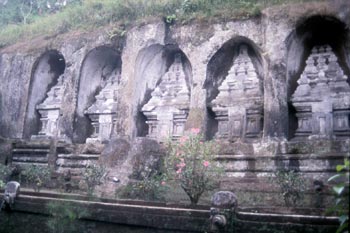| Ubud | Temples |
An unspoiled paradise?
With its beaches, surf, lush interior with volcano and rice terraces and the artistic culture of Southeast Asia's only Hindu society Bali is a paradise. But Unspoiled? Even before the terrorist bombing of October 2002 which killed over 200 people Bali suffered the usual tourist problems of crowds and commercialization. Bail is the number 1 foreign
destination for Australia with the majority of Bali's 2 million yearly visitors travelling from
Australia.
Even before October 2002 Bali had a sometimes bloody past. Colonilized by the Dutch in 1849 and occupied by the Japanese in World War II it became an autonomous state in 1948 but tensions with Java lead to the Gestapu affair in 1965 with the death of 100,000 people. People in Bali still have unpleasant things to say about people from Java.
Most tourists crowd the area at Kuta beach, six kilometres of beach with plenty of restaurants,
accommodations and nightlife but at over 10,000 km2 you can avoid the crowds, there are less crowded beaches on Bali and if you want you can totally avoid the beach culture.
|
Watch out for the traffic, in my experience the world's worst drivers are in Bali. Some people disagreed with me claiming Turkey or Nepal have worst drivers. Haven't visit either country, yet, I can't vouch for that but it must be pretty bad. Even the tourist literature tells you to watch yourself; cars might stop, motorcycles might not. I even saw families of four riding a motorcycle. There are no driving exams you just buy your drivers license. Watch out for the touts at the airport, some of the most aggressive I have yet encountered. Usually in most places the touts are waiting outside but in Bali they are located in the air terminal and even wear an official-looking uniform. If you are not quick they will grab your luggage from the carousel then demand a huge tip to carry it 10 metres. With the touts at the airport and the bad taxi drivers its not a good introduction to the island. Our taxi driver ran over several ducks and a dog from the airport to our hotel in Ubud. Never slowed down. UbudThis is the community to visit if you have any interest in Balinese culture, or have no interest in beach culture. Often called the cultural capital of Bail, the real capital is Denpasar which you will have to drive through from the airport, Ubud and the adjacent villages still paint, carve, dance and make music and there seems to be some sort of festival in the area every day. The major attraction in Ubud, besides its natural setting in the hills of Bali are the art museums, galleries, and cultural attractions. Although Ubud has a central museum, the two main art galleries, Neka Art Museum and Agung Rai Museum of Art, have more impressive collections. The galleries contain both old and new works and works by local artists and ex-pats. I noticed some of the older painted featured topless women. I assumed that early Christian and/or Islamic missionaries made the women of the island coverup. No. It was not until the Japanese invasion and the women believed if they covered up the soldiers would not rape them. Ubud's best known attraction is the Monkey Forest Sanctuary (Mandala Wisata Wenara Wana) because of its three resident troops of Balinese macaques, about 200 in total. There are also three small temples built during the mid-14th century. The most interesting is the Holy Bathing Temple located down a long flight of stairs and next to a stream. This forest is the monkeys home you are only a guest. I know its common sense but I think some tourist leave their common sense home when they travel. The monkeys are wild animals, they will take food from your hand but they can be aggressive. Booths near the entrance sell fruit for people to feed the monkeys. |
|
Ubud is also the place to visit for traditional dance performances and there can be up to 5 different shows each night, cost is about 50,000 rupiah (about 8 dollars), the performance at the Ubud Palace is worth it just for the surroundings of the former raja's home.
 |
 |
 |
Temples
With about 3 million people Bali supposedly has close to 40,000 temples. The main religion is Agama Hindu Dharma which arrived in Bali in the 11th century. Although originally from India it has been influence over the years by Buddhist, Javanese and indigenous beliefs. With the Islamicization of Java in the 15 th century a large number of Hindu fled to Bali. The religion is very different from the Hinduism practiced in India. There are no untouchables and your occupation is not governed by your caste. With all these temples you are sure to see some type of festival.

The main temple complex on Bali and a major tourist draw is the Besakih temple complex, which is visited by about 250,000 people a year. The day we visited was also a major festival so we were expecting crowds but even though it was almost a year since the terrorist attack in Kuda there was maybe only a dozen other tourist there. Plenty of locals dressed in their finest with plenty of offerings.
Besakih is a jumble of buildings with 22 separate temples spread over a site stretching over 3 kilometres. It is situated at the base of Gunung Agung which at 3142 metres is the tallest in Bali and last erupted in 1963. Hikes can be arranged to climb the mountain.
Other worthwhile temples to visit on Bali include Goa Gajah also called the Elephant Cave, though to be built in the 11th century. Several of the statues at the site still have water flowing out of the statues although a recent earthquake has caused the water to stop flowing in one of the statues. A bit further away is Yeh Pulu which has a series of 25 metre long carvings chipped away from the sheer rock face. The path to the carving is through several rice terraces, this is a rarely visited site and is worth a visit.
The village of Tenganan is visited by many tours. It rejected the Javanization of the island and is a glimpse into a more traditional village life. A lot of traditional art can be purchased in the village.
Many of these sites can be visited on cheap local transportation but for convenience I recommended going on a private tour. A driver and vehicle can be had for about $US45 for the day. The entrance fee at most temples is about Rp10,000. Our driver claimed to learn English by watching American movies, his English was pretty good.
An unspoiled paradise? No, but it still a special place. For an area that combines beach and culture the only other area I found better was the Mayan Riviera in the Yucatan Peninsula in Mexico. Yes its commercial but you can avoid the over commercialized areas if you want and the island is large enough to contain plenty of other activities for those who get easily bored by lying on the beach.
Will I ever return? There are plenty of places I have yet to visit but I hope to return and visit other islands in the Indonesia archipelago.
| Return to Travel Page |
Return to Main Page |
